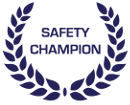March is approaching swiftly. So, if you haven’t started your safety planning yet, it may mean you’re stuck or not sure where to start. But that’s totally ok. At Safety Champion, our mission is to provide clear and simple direction to uncomplicate safety management. In fact, during the last half of 2018 we held a four-part health and safety 101 webinar – The War on Safety – with this simple objective.
A number of attendees of the War on Safety mentioned that they found little nuggets of gold within the series that helped them look at their health and safety program in a slightly different way. Attendees mentioned they felt more confident to ‘do safety stuff’ and improve things at their workplace, without an increase in perceived effort. One little nugget stood out and it was this:
Identify what can hurt people in your workplace, then, actively work towards fixing and managing those things so people don’t get hurt.
So simple.
So if you are stuck with where to start your safety planning for 2019, this is our best piece of advice for a starting point. The truth is, if you do this well, you are likely to be doing safety extremely well.
But what does this look like in practice? Here’s some practical step-by-step advice for how you could approach this:
- Schedule a meeting (as a collective, or as individuals) with people across the business who undertake operational activities.
- Ask your team what they understand to be the health and safety risks associated with their work – don’t talk, listen.
- If they have a long list, potentially ask them to identify the:
- two (2) hazards that could have the greatest consequence (i.e. where they, or others could be seriously injured, or even die); and,
- two (2) hazards that they are exposed to, which they have to manage regularly. These hazards may have a minor, or significant consequence.
Remember: Don’t challenge. You asked for their opinion. You already know and have your opinion. After this meeting you can work together to manage hazards that all parties see as reasonable and practicable.
- Without challenging your team, working through the hazards identified within point 3, or points 3(a) and 3(b). Ask them, what do they do to ensure that people don’t get injured as they perform their tasks at work – again, don’t talk, listen.
- Thank them for their role in establishing a safer workplace.
- Then ask, what else could they, or the business, do to better ensure that people don’t get injured. If you do start to have a conversation here, don’t comment negatively towards their suggestions.
- Document the conversation – if you need a tool to support documentation, contact us, and we will provide you with the template that we have made available to all of our Safety Champion Clients within our Version Control and Documents Module.
A lot of businesses get so overwhelmed by the ‘doing’ of safety. This is often because they don’t involve their workers. They forget that in its rawest form, safety is about preventing incidents. They find it hard to start, because they look to do ‘legal compliance’ rather than explicitly looking at ways the work that they do, could hurt their workers, or people exposed to the work that they do.
But our advice? Initially focus on this. Once you identify a way that your workers or others could get hurt, you can then explore the legislation and guidance material to familiarise yourself with appropriate methods of control.
Once you have identified things that you will do to reduce the likelihood people getting hurt by your operations (i.e. via training, meetings, inspections, maintenance, etc.) document this, set-reminders, build sustainability. This is what managing your health and safety obligations looks like.
We feel incredibly privileged to hear such positive feedback from the people who joined the War on Safety webinar series. Not only has this feedback helped us to refine and improve the way our Action OHS Consulting consultants work with clients, or how our software Safety Champion functions; it was also just awesome to hear from listeners telling us that they were now confident to talk about safety within their workplaces.
We’re heartened by this – because as safety geeks ourselves – what we really want is to build safer and happier workplaces.
If you are keen to download the full War on Safety Webinar series so you can get safety sorted for 2019 from today – do so here.









